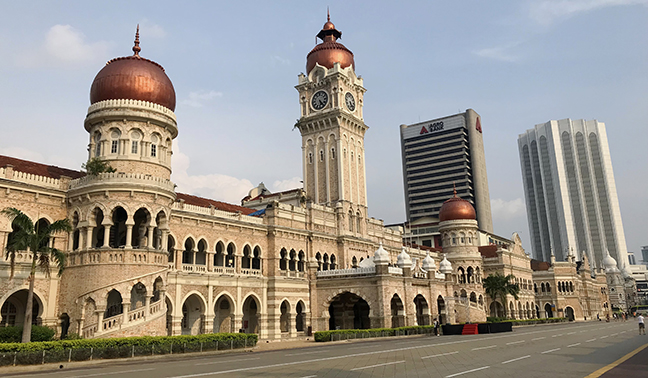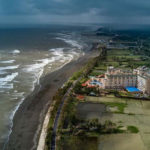Kuala Lumpur ’s multi-racial history is reflected in city’s mosques, temples and government buildings
Few cities can surpass Kuala Lumpur in the sheer variety of architectural wonders, which reflect the cultural influences that shaped the city’s skyline. Ultra or post-modern buildings like the Petronas Tower of Dayabumi Complex have their place of pride in history books, but that said, nothing is more important to the local fabric of life than an intricately designed mosque, a Malay-style wooden place of worship, Chinese temples, or a shophouse.
Look closely at the city’s architectural wonders and it will be impossible to say what makes it more fascinating – the towering, postmodern Petronas Tower, the Grecian-Spanish styled white and red St John’s Institution or the Moorish styled Sultan Abdul Samad building.
Kuala Lumpur is a rather young city and most of its distinguished structures were built at the end of 19th century and the turn of the 20th and blended Asian traditions (including Malay, Dravidian and Chinese), Islamic inspiration and colonial influence. Making today’s KL is a mix of modern and post- modern architecture. However, these buildings are not just pretty sights that look great on postcards – they are evidences of different eras of influence in Malaysian history.
Islamic influence
Post independence, KL’s Islamic influence is seen everywhere and an exploration of the city will acquaint you with many examples of this. Mosques, palaces and even homes are adorned with motifs and calligraphy and etchings of Quranic verses can be seen everywhere. That said, even the 452 m high Petronas Twin towers when seen from above, resembles the Islamic geometric motifs – although from the ground level, its all-glass façade gives it a futuristic post-modern appearance.
The Putra Mosque (Pink Mosque), KL’s newest eye-catching masterpiece with its rose-tinted granite glistening in the sunlight reflected on the bay, is a classic example of a fusion of various architectural styles and reflects the true spirit of Malaysia, while some places like the National Planetarium masquerade as a place of worship, complete with dome and a minaret, is actually a place of science.
Did you know
Plenty of structures in the city have Moorish influence, most notably Sultan Abdul Samad built in the 1800s – and is mistaken for the Sultan’s former palace! In reality, it was constructed as a government office and has a copper dome and clock tower that houses at 1-ton bell.

The area of Dataran Merdeka has a highest concentration of Moorish style buildings and the most eye catching of all is the KTM railway station built in 1910. Also, another classic example of Moorish architecture is the 1904 built Panggung Bandraya Theatre, the National History Museum and the old Sessions and Magistrate Court.
Tudor and Victorian
At the turn of the 20th century, many important buildings were constructed in the Tudor and Victorian- style, although modified to suit Malaysia’s tropical climate. While many have since lost their importance, two sporting clubs The Royal Selangor Club and Selangor Chinese Club with its half-timbered walls continue to charm the history buff and add a new dimension to Kuala Lumpur’s historic side.
Many of the city’s places of worship are examples of Gothic and neo-Gothic styles that was once common – namely the St Mary’s Cathedral, St Andrew’s Presbyterian Church, Church of the Holy Rosary and St. John’s Church (now Bukit Nanas Community Center). Besides these churches, the residence of Sir Frank Swettenham the British administrator was built in the neo-gothic style in 1897. Lately this building was featured in movies like The Seventh Dawn and Crazy Rich Asians among others.
Tucked away in the areas of Chinatown, Jalan Tuanku and Bukit Nanas are charming shophouses, one of the most eye-catching works of architecture in KL and with interesting history to it. These character filled and colourful houses, true to their name were two-storey houses with a functional shop on the ground floor and living space on the first were built prior to the Second World War (with Chinese influence similar to the terraced houses of Europe), while the imposing red and white brick building of St John’s institution in Bukit Nanas and the Telecom Museum (1928) is famous for its Grecian-Spanish architecture.
The modern Kuala Lumpur
The evolution of architectural styles over the decades is a story of triumph. While many cultural heritages that existed in the colonial times influence the country’s cultural development today, the present- day KL’s central business district that has sprung around the Kuala Lumpur City Centre (KLCC) has given the city a post-modern appearance. Tall, gleaming structures fill the skyline, while the KL Convention Centre with its all-glass shell gives the city a futuristic look.
While you are here
Check out the vibrant murals that have taken over the Bukit Bintang and Jalan Alor area.
Read more
The kingdom of traditional jewelry : Bhakurta
Rangamati : A Fairytale District
The Wilayah Mosque is one of the only mosques in Malaysia that non-Muslim can enter, although you will require a guided tour for this.





















